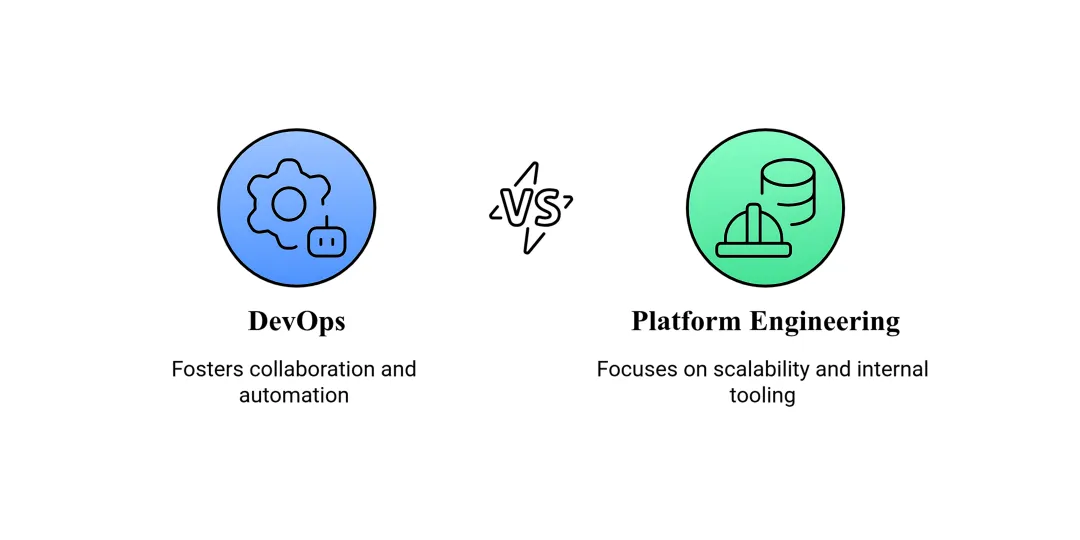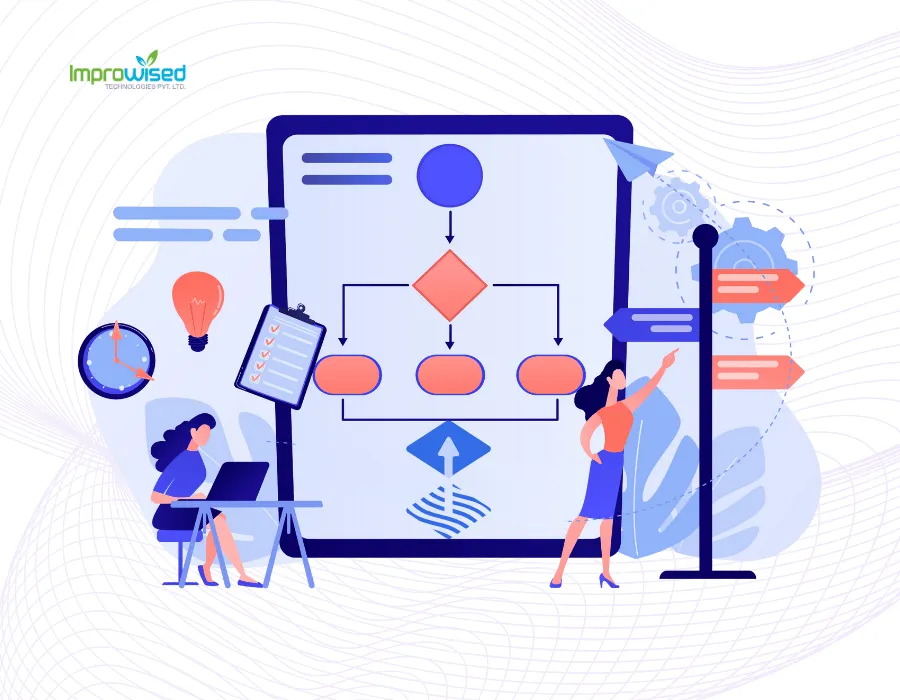August 4, 2025
What are the differences between platform engineering and DevOps and which one is best for your team?

By Improwised Editorial Team
Improwised Technologies Pvt. Ltd.
In the world of software development today, engineering teams are under more and more pressure to deliver faster, more reliably, and on a larger scale. DevOps, Platform Engineering, and Site Reliability Engineering (SRE) are some of the most important fields that have come up to address these needs. They may look the same at first, but each one has a different job to do to help with fast software delivery and operational excellence.
This article talks about the differences and similarities between platform engineering and DevOps, as well as how they are different from and occasionally the same as SRE. You’re at the perfect place if you’ve ever wondered what the difference is between a DevOps engineer and a platform engineer, or which model is optimal for your organization’s level of maturity.
Let’s first briefly explain what DevOps, Platform Engineering, and SRE are and how they fit into modern software development workflows before we get into the main distinctions and strategic importance of each method.

What is DevOps?
DevOps is more than just a job; it’s a way of thinking about engineering and a cultural movement that breaks down the barriers between software development and IT operations. It encourages people to work together more closely, get feedback more quickly, and share the responsibility for making and running high-quality software.
The main idea behind DevOps is to build a culture of flexibility, responsibility, and constant growth. Instead of developers just developing code and sending it to operations, DevOps encourages teams from different departments to work together to build, test, deploy, and monitor software.
The DevOps Toolchain
DevOps needs a strong toolchain that automates and speeds up the software delivery lifecycle to enable this culture:
- CI/CD (Continuous Integration and Continuous Delivery) automates the process of integrating, testing, and deploying code to cut down on mistakes made by hand and speed up the release cycle.
- Infrastructure as Code (IaC): lets teams set up and govern infrastructure using machine-readable specification files (like Terraform and Ansible). This makes it possible to keep things the same, do them over and over, and keep track of different versions.
- Monitoring and Observability: Tools like Prometheus, Grafana, and Datadog let teams see how well their applications are working, how often they go down, and how healthy their systems are, so they can find and fix problems quickly.
DORA Metrics: How to Tell if DevOps is Working
Many teams use DORA (DevOps Research and Assessment) metrics, which are an industry standard created by Google Cloud through research, to see how well DevOps approaches are working. These four important metrics are:
- Deployment Frequency: How often code is put into production.
- Lead Time for Changes: the time it takes for a code commit to go live in production.
- Change Failure Rate: The percentage of deployments that fail.
- Mean Time to Recovery (MTTR) is the time it takes for teams to get back to work after a failure in production.
DevOps teams that do well tend to deploy more often, recover more quickly, and have fewer errors. This makes them more flexible and able to respond to markets that move quickly.
What does it mean to be a platform engineer?
Platform Engineering MIME is a new field that focuses on creating and managing internal platforms that let development teams get the tools and environments they need to build, test, and distribute software quickly and safely. Platform engineering is more product-focused than DevOps, which focuses on culture and processes. It sees the platform itself as a product that serves internal teams.
At its core, platform engineering is about making reusable building blocks and standard paths that make things easier for developers, boost their productivity, and enforce best practices without being too severe.
What IDPs (Internal Developer Platforms) Do
The Internal Developer Platform (IDP) is a core output of platform engineering. It is a carefully chosen set of tools, procedures, and services that make infrastructure less complicated so developers can focus on deploying features.
You can think of an IDP as a self-service gateway or control plane that lets developers do the following:
- Environments on demand
- Automated CI/CD pipelines
- Safe administration of secrets
- Providing infrastructure that can grow
- Standard integrations for monitoring and logging
This method helps make sure that everyone follows the rules, that things are always the same, and that things can grow. This is especially crucial for big companies with a lot of engineers or startups that are growing quickly.
The Idea of “Golden Paths”
The “Golden Path” is another important idea in platform engineering. It is a technique to build and deploy applications in an organization that has been approved, well-documented, and supported. These are opinionated workflows that strike a balance between freedom and rules, so teams don’t have to start from scratch or make choices that put them at risk of technical debt or security breaches.
Golden paths assist organizations in dealing with a big problem: too many tools and inconsistent use of DevOps principles. Platform engineering gives teams both freedom and control by leading them down paved routes that are easy to follow.
SRE in the Mix: Where Reliability Takes the Lead
Site Reliability Engineering (SRE) focuses on making sure that systems are reliable and always available. DevOps focuses on collaboration and automation, and Platform Engineering creates the internal tools to make development easier. SRE started at Google and uses software engineering principles to improve infrastructure and operations. The main goal is to make systems scalable, resilient, and always available.
What Sets SRE Apart?
At first glance, SRE could seem like just another kind of DevOps. But it does have certain unique ideas and ways of doing things that make it stand out:
-
Reliability as a Goal That Can Be Measured:
SRE teams don’t just want things to be stable; they measure it. Service Level Objectives (SLOs), Service Level Indicators (SLIs), and Service Level Agreements (SLAs) are all ways to do this. These metrics tell you how much uptime or performance a service should have. -
Budgets for Errors:
This is where SRE shines. SRE doesn’t try to obtain 100% uptime, which can hold teams down. Instead, it sets an “error budget,” which is a limit on how much failure is acceptable. Developers can keep making improvements as long as a service stays under its error budget. But if that budget is too high, the focus changes from adding new features to keeping the system stable.
It’s a practical technique to find a balance between new ideas and dependability. -
Automation as a First-Class Person:
SRE values automation like DevOps and Platform Engineering do, but it goes much farther. SREs are taught to “automate themselves out of a job,” which means they try to get rid of toil (manual, repetitive work) by using scripts, bots, and infrastructure automation. This makes sure that teams can grow systems without having to hire more people.
How SRE Fits in with DevOps and Platform Engineering
Think of it this way: if you’re trying to decide between DevOps, SRE, and Platform Engineering:
- DevOps defines the rules and ways of working for shipping code together and all the time.
- Platform Engineering makes the internal tools and “golden paths” that speed up and standardize development.
- SRE makes sure that what gets supplied is reliable, strong, and fulfills the performance standards that everyone agrees on.
SRE methods can often be part of DevOps responsibilities for new businesses. In businesses, SRE is usually a separate job, especially as systems get more complicated and downtime costs more.
A Comparison of DevOps and Platform Engineering
It’s evident now that DevOps and Platform Engineering are quite similar, although they have different jobs. One concentrates on culture and ways to automate things, while the other constructs internal systems that can grow to support those practices on a large scale.
Here’s a side-by-side comparison based on real-world examples from companies like Spacelift, Puppet, and Qovery to help CTOs, engineering leaders, and expanding teams figure out what works best for them.
| Category | DevOps | Platform Engineering |
|---|---|---|
| Primary Focus | Speed, collaboration, and continuous delivery | Scalability, developer experience, internal tooling |
| Philosophy | Culture + automation + shared responsibility | Treating internal platforms as products |
| Responsibilities | CI/CD setup, infrastructure automation, monitoring, and incident response | Building and maintaining Internal Developer Platforms (IDPs), golden paths |
| Tooling | Jenkins, GitHub Actions, Terraform, Prometheus, Docker, Kubernetes | Backstage, Crossplane, Internal CLIs, self-service dashboards |
| Who They Support | Developers + Ops (hands-on across lifecycle) | Developers (via abstraction, tooling, self-service) |
| Team Structure | Often embedded within teams, fewer boundaries | Dedicated platform team, cross-functional with clear interfaces |
| Level of Maturity | Effective at early to mid-stage growth | Typically seen in scale-ups or enterprise orgs with platform complexity |
| Measurement | DORA Metrics: Deployment frequency, lead time, change failure, MTTR | Developer satisfaction, onboarding time, and internal tool adoption rates |
| User Experience | Developers manage CI/CD pipelines and infrastructure directly | Developers use standardized templates and workflows (via IDP) |
| Governance & Control | Decentralized, faster experimentation | Centralized, enforces consistency, security, and compliance |
Choosing the Right Thing
- DevOps approaches are generally the first thing that startups and younger teams do since they are simple, adaptable, and easy to utilize. But the more complicated things get, the more important it is to think about platforms.
- Platform Engineering helps businesses and scale-ups standardize, lower cognitive load, and keep developer speed high without giving up control.
In the end, it’s not DevOps versus. Platform Engineering; it’s DevOps with Platform Engineering when your team and scale need it.
Overlap and synergies: DevOps as a Service
DevOps and Platform Engineering don’t really work in separate areas. They commonly work together, especially as businesses grow. A lot of smart teams are combining the best of both worlds with models like DevOps-as-a-Service, where a central team or partner offers DevOps features as reusable, scalable services to the whole business.
This is where Platform Engineering shines - not as a replacement, but as the next step in the growth of DevOps.
The Next Step in DevOps: Platform Engineering
DevOps set the stage for automation and collaboration. Platform Engineering constructs the highway by making sure that developers can always use the same paths. It makes sense of the creative chaos that may happen when each DevOps team makes its own CI/CD pipelines, scripts, and environments.
Platform engineering brings standardization, scalability, and self-service to the table so that each product team doesn’t have to keep fixing the same infrastructure issues. It turns DevOps methods into products, which makes them easier to use and safer by design.
This is how to think about it:
- DevOps gets things done.
- Platform Engineering makes them easy to reproduce, fast, and without problems.
DevOps-as-a-Service: A Useful Middle Ground
For a lot of new businesses or teams that are growing quickly, it’s not possible to develop a full-fledged platform team right away. DevOps-as-a-Service is the answer to this problem. It can come from an inside platform team that offers tools and infrastructure as services that can be used again and again, or from an outside partner.
This model looks like this:
- Instead of making their own DevOps tools like CI/CD pipelines, Kubernetes templates, and IaC modules, teams use them.
- Using approved and supported pathways, developers may deploy faster and with more assurance.
- Leadership lowers risk, keeps expenses in check, and speeds up time-to-market—all without slowing down new ideas.
It’s a good first step for businesses who desire the benefits of platform engineering but aren’t ready to develop a complete internal platform team yet.
The key to success for both small and large businesses is knowing where DevOps ends and Platform Engineering begins, and how the two work together. One gives you flexibility, and the other gives you size. When they work together, they build a system that moves quickly and lasts.
When to Use Which
Now that we’ve looked at the differences between DevOps, Platform Engineering, and SRE, let’s get to the point:
Which method is best for your team, and when?
Two main things affect the answer:
- How mature your product or engineering is, and
- The size and difficulty of your infrastructure.
This is how it usually goes in real life:
If You’re a Small Business (Seed to Series A)
At this point, getting things done quickly is more important than doing them flawlessly. You probably have a small crew that does a lot of different things, like developers who set up infrastructure, deploy code, and fix outages. DevOps is your best buddy here.
-
Why DevOps Works Best:
You need to be quick. A lean DevOps approach gives your team the tools they need to automate tasks, manage infrastructure as code, and move quickly without a lot of red tape. -
How It Looks:
- GitHub Actions or GitLab for CI/CD
- Terraform or Pulumi for Infrastructure as Code
- Golden routes that are governed through documentation and Slack conversations (if any) -
What Platform Engineering Does
Not yet. You may start gathering ideas for standardization, but at this point, it’s too much work to develop a separate platform team.
If You’re a Scale-Up (from Series B+ to Growth Stage)
Right now, you’re shipping quickly, but you might be having problems with fragmentation. Teams make their pipelines, the infrastructure settings are different, and it takes too long to get new people up to speed. It’s time to start thinking like a team that builds platforms.
-
Why Platform Engineering Makes Sense Right Now:
You want to keep moving forward while lowering your tech debt and mental load. Developers shouldn’t have to deal with YAML every day. -
What You Could Make:
- Using technologies like Backstage or Port to build an Internal Developer Platform (IDP)
- Predefined golden routes for deploying microservices
- A common platform team manages Kubernetes clusters
- The “DevOps-as-a-Service” approach is used internally, with a central infrastructure team providing reusable CI/CD templates, secrets management, and other services.
If You’re an Enterprise or Work on a Huge Scale
Now you have to deal with hundreds or thousands of engineers, tight compliance needs, and the necessity for your system to be up all the time. Your teams need to be able to make their own decisions, but your systems need to be the same all the time. This is when Platform Engineering and SRE really get going.
-
Why Platform Engineering is a Must:
Without standards, scaling becomes a mess. IDPs, paved routes, and dedicated platform teams are all important for keeping developers busy and infrastructure under control. -
Where SRE Comes In:
Your systems need to be strong. SRE makes a guarantee that production systems are always available by using SLOs, error budgets, and automating work that doesn’t need to be done.
Quick Breakdown of Use Cases
| Scenario | Recommended Approach |
|---|---|
| Startup building MVP | DevOps |
| Teams struggling with inconsistent tooling | DevOps + Light Platform Practices |
| Scaling from 20 → 100+ engineers | Platform Engineering Starts to Take the Lead |
| Compliance/security is becoming a bottleneck | Centralized Platform + SRE |
| Devs are complaining about infra complexity | Internal Developer Platform (IDP) |
| Multiple teams duplicating CI/CD pipelines | DevOps-as-a-Service + Golden Paths |
| Uptime is a core business KPI | SRE + Platform Engineering |
Conclusion: Setting Up Your Engineering Team for Success
In the fast-changing world of modern software delivery, choosing between DevOps, Platform Engineering, and SRE isn’t about picking a winner. It’s about knowing what your team needs right now and where you want to go in the future.
Let’s go over it again:
- DevOps does things faster, encourages teamwork, and creates a culture of shared ownership. It’s a terrific place for teams to start if they want to work together and ship faster.
- Platform Engineering takes that base and makes those processes more consistent and scalable by giving developers internal tools and “golden paths” that make them more productive without losing control.
- Conclusion: Setting Up Your Engineering Team for SuccessSRE steps in when dependability is really important. It provides structure through SLOs, automation, and a strong focus on uptime and resilience.
Each one has a different but related job to do when it comes to how modern teams design, build, and run software. Don’t think of them as competing methods; instead, think of them as partners in your advancement.
The most important thing is to make sure that your engineering strategy matches your product, team size, and operational complexity, whether you’re a new business just getting started or a large company with hundreds of services.
Don’t Know Where Your Team Stands?
It’s quite reasonable to have questions if you’re attempting to figure out the pros and cons of DevOps, Platform Engineering, and SRE, or what the best option is for your current stage.
That’s why we’ve made a detailed FAQ section to assist you in understanding typical worries and misunderstandings.
Still not sure or need guidance that fits your situation? Get in touch with us directly. Before we suggest a way forward, we make sure we thoroughly grasp both your technological architecture and your commercial goals.
We have worked with engineering teams at both startups and large companies to make infrastructure more efficient, update delivery pipelines, and create internal platforms that can grow.
We are more than simply a vendor; we are your engineering partner. You can focus on making your product while we handle everything from CI/CD to platform strategy.
Let’s talk and see how we can help you save time, make things easier, and propel your team forward with confidence and clarity.
Frequently Asked Question
Get quick answers to common queries. Explore our FAQs for helpful insights and solutions.


By Shyam Kapdi
Improwised Technologies Pvt. Ltd.

December 17, 2025
Cloud to On-Premises Migration: Costs, Performance & Strategic Benefits

By Shyam Kapdi
Improwised Technologies Pvt. Ltd.

December 12, 2025
Continuous Deployment with FluxCD: Architecture, Flow & Best Practices

By Shyam Kapdi
Improwised Technologies Pvt. Ltd.
Optimize Your Cloud. Cut Costs. Accelerate Performance.
Struggling with slow deployments and rising cloud costs?
Our tailored platform engineering solutions enhance efficiency, boost speed, and reduce expenses.
